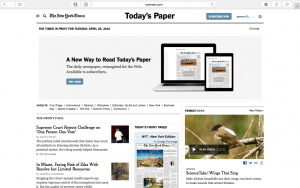As distribution systems have evolved over the last few centuries, journalism has been forced to evolve as well. Over time the shift in these systems have had both positive and negative effects on journalism over time.
Distribution systems have always had an impact on journalism. In the early days of the printing press, before movable type, printing was a modest means of distribution, but not powerful enough to make mass production either affordable or useful.
With the development of movable type came an increase in distribution as the system became more efficient and less expensive. The result was the spread of information like Martin Luther’s 95 Theses in ways that were impossible before this new system had been implemented.
Today we see the most obvious effects of a change in distribution systems in the amount of newspapers that have been forced to close due to lack of print circulation. Papers like the Baltimore Examiner, Kentucky Post, and Tuscon Citizen have all gone under during the shift from a print only distribution system to a print and digital system.
This shift in distribution systems has changed not only newspaper companies themselves, but also consumers. As the digital platform gained popularity, news consumers became accustomed to being able to read breaking news stories immediately whereas print newspapers could only report on what had happened before the time they were sent to presses.
The shift to digital media also came with new sources of news. Newspapers were not the only entities now beginning to publish content online, as many other media companies, as well as individuals on social media also were able to use the digital platform. Newspapers were not prepared for this increased competition, as well as giving away content for free as many unofficial news sites like Twitter can.
That being said, the rise of the digital platform has not wiped out the print distribution system or the appeal of print news for that matter. In fact, as the chart to the right shows, most news consumers still heavily use the print format.
This combination between print and online content has become the feature of many news companies like the Washington Post, New York Times, and USA Today. The next shift in journalism is hard to imagine, but if it is anything like movable type shift or the digital medium shift, it should be an incredibly interesting time to be a journalist.
Sources:
http://www.nytimes.com/pages/todayspaper/index.html?action=Click&module=HPMiniNav®ion=TopBar&WT.nav=page&contentCollection=TodaysPaper&pgtype=Homepage
http://www.journalism.org/2015/04/29/newspapers-fact-sheet/



Leave a response